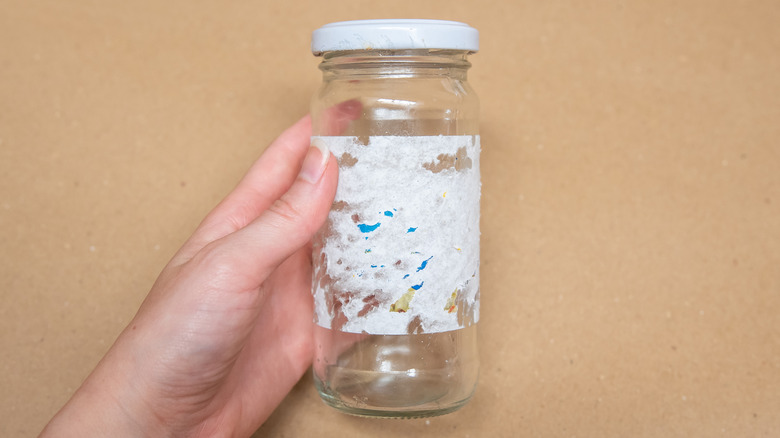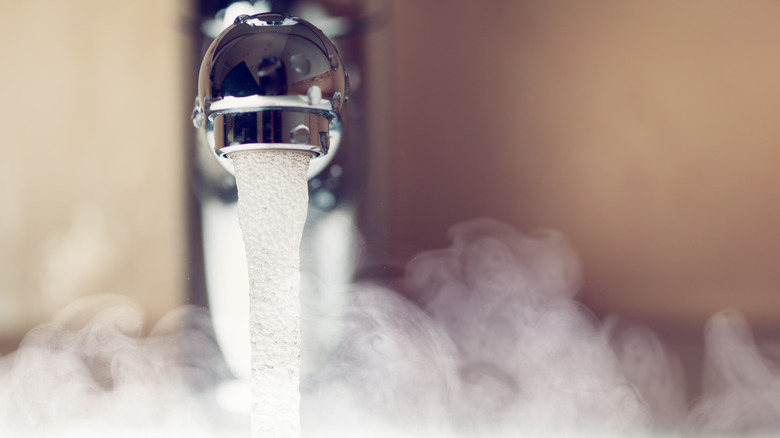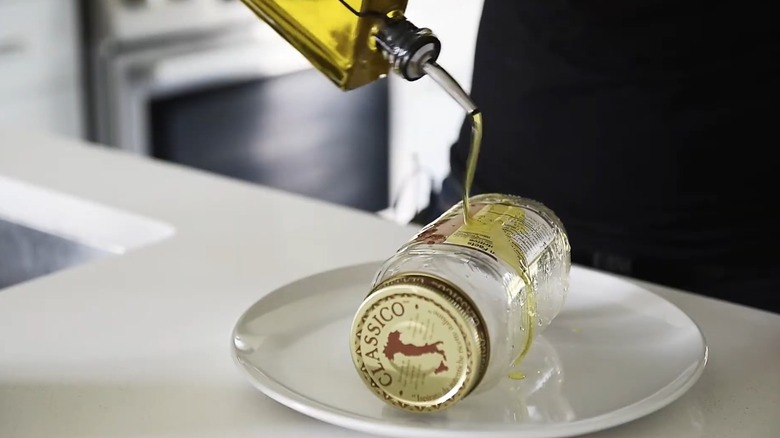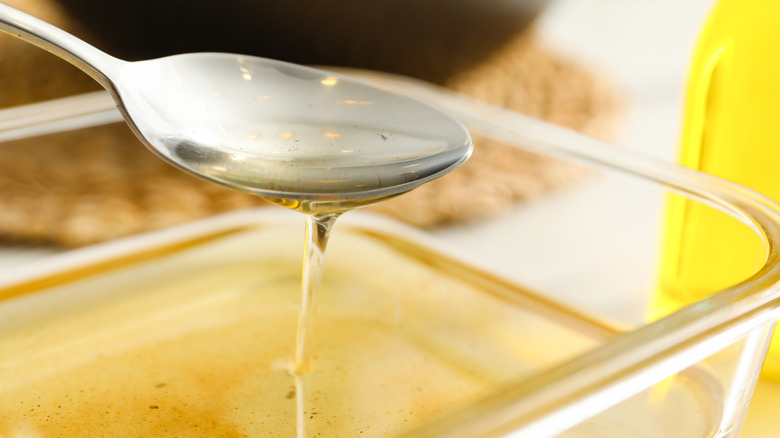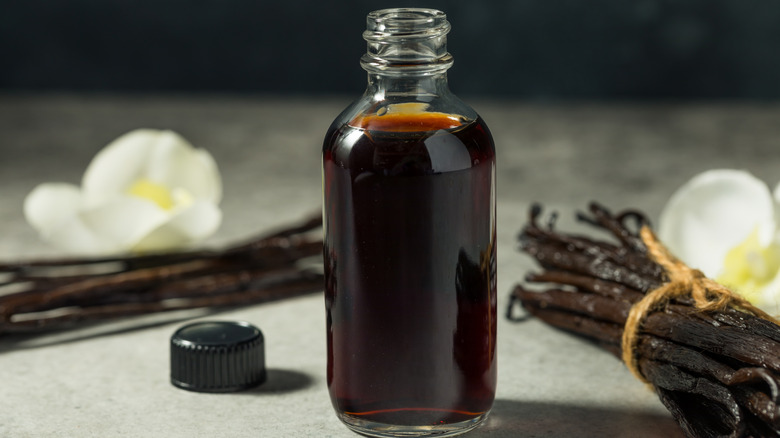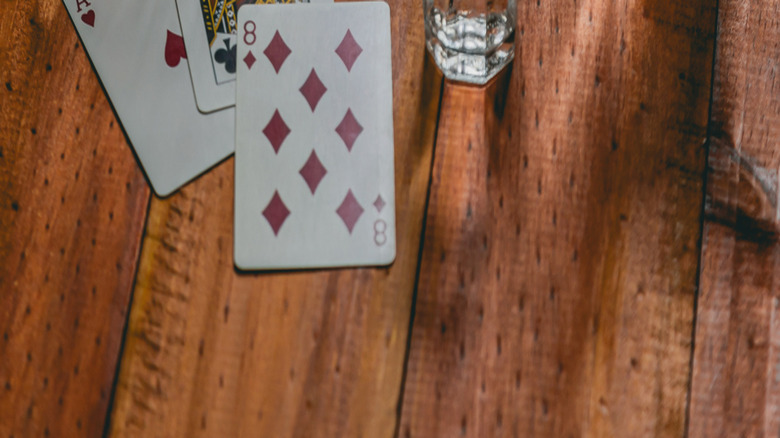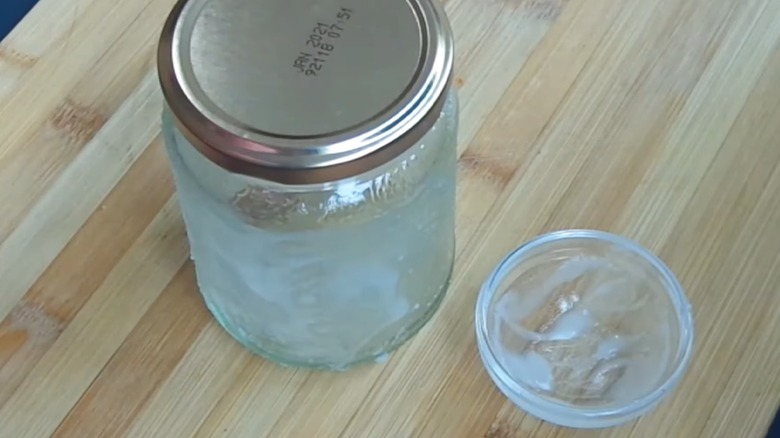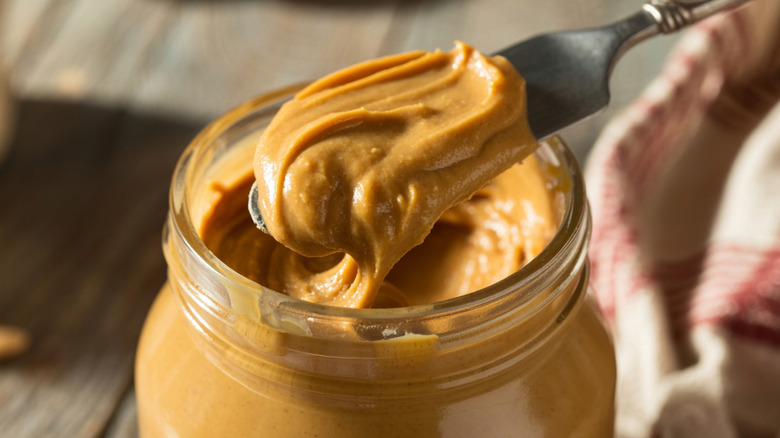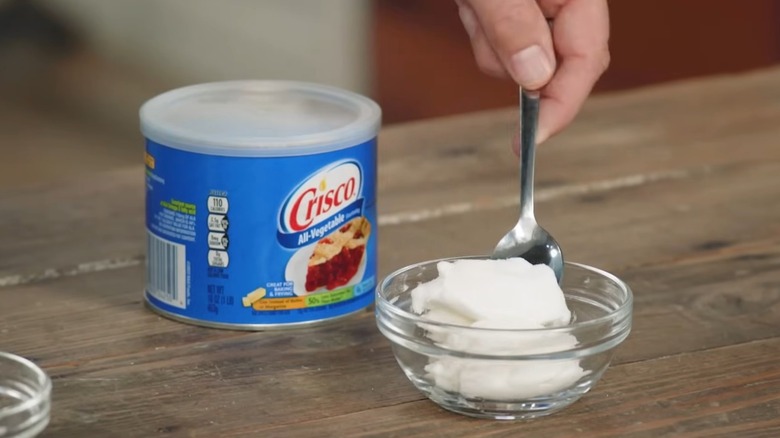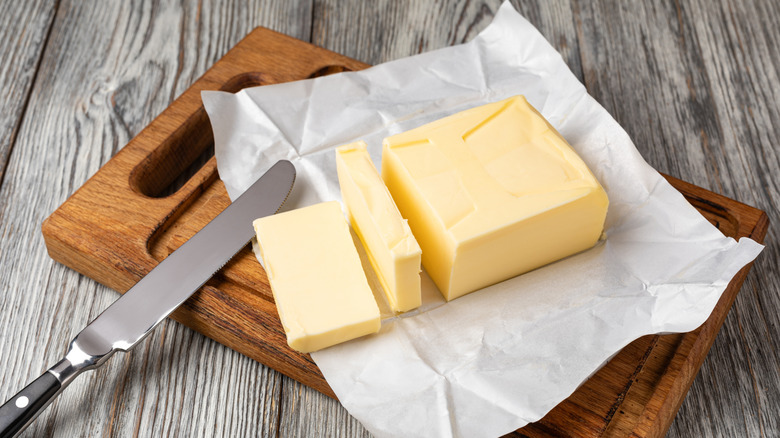13 Household Ingredients That Can Remove Stickers (And Residue) From Glass Jars
If you're a fan of DIYs, then you know that glass jars are very versatile. From handmade soap dispensers to dainty lights to brighten up your space, the sky's the limit when it comes to how you can reuse a leftover jar after you've finished your jam or condiment. However, when you want to get crafty, there's one hurdle to overcome before your jar is DIY-ready: Removing the label.
Sometimes, when you go to remove a label from your jar, it comes away in one motion with no residue left behind. However, in other cases, you may be left with a half-peeled sticker or gooey residue that won't come off. While this can be fine if you're reusing your jar in the kitchen for storage, for DIYs and other projects, you likely want a clean jar. Fortunately, there are a variety of household ingredients you probably already have on hand that can make removing stickers and residue from glass jars a breeze, including everything from water to vinegar to lemon juice.
Warm water
One of the easiest ways to remove a stubborn label or sticky residue from a glass jar is to use warm water. Not only do water and heat pair together to loosen adhesives, but if you need to clean multiple jars at once, removing labels can be as simple as placing all your jars in a sink filled with water. If you plan on using this method, just make sure you're not using water that's too hot; otherwise, your jar may crack. Warm water can also be a helpful starting point before using the other listed ingredients.
Olive oil
Warm water alone may not be enough to remove a sticker from your jar or the residue it may leave behind. As a result, you may find yourself looking for a stronger solution, such as olive oil. To try out this method, simply apply olive oil to the target area. You may want to scrub using a rag or leave it to sit before rinsing the oil and residue away with warm water. For those using a rag, keep in mind that oils like olive oil can easily stain cloth.
Vegetable oil
If you're an avid cook, you may not want to use your precious extra virgin olive oil for removing sticker labels. Fortunately, olive oil is not the only cooking oil that you can use to upcycle glass jars. Vegetable oil is another common household ingredient that can remove sticker labels, with the oil loosening the sticker for removal that's a breeze. The process is the same as using olive oil to remove stickers from glass jars: Simply add your vegetable oil, allow it to sit or scrub for more stubborn residue, and wash as normal.
White vinegar
Because vinegar is so acidic, it can be used to break down the adhesives holding your sticker in place. As a result, if you need a budget-friendly way to clean sticky residue from glass jars, white vinegar can be the way to go. To clean jars using this method, soak a paper towel, cotton ball, or pad, or similar material in vinegar. Then lay it on the sticker. For thin or partially removed labels, you may only need to let the vinegar sit for five minutes. Tougher labels may need up to 20 minutes and beyond.
Vanilla extract
Vanilla extract provides a food-safe alternative to rubbing alcohol to remove that pesky residue standing between you and your next DIY. This is because vanilla extract has the same proof of alcohol as many types of liquors, and alcohol can be great for breaking down leftover labels that just aren't cooperating. Like with other sticky residue removal methods, using vanilla extract to remove stickers often works best when you've removed as much of the label as possible. Use a cotton ball to soak the label in vanilla extract, then scrape away the sticker with ease.
Vodka
Pure vanilla extract can be pricey, especially if you choose a high-quality option. As a result, you may want a more budget-friendly alternative to removing labels without wasting this precious extract. Fortunately, there are many ways to use vodka around your home, and label removal is one of them. Like other strong alcohols, vodka can break down sticky adhesive, making removing labels from your jar as simple as soaking and scraping away any remains. If you do use vodka to remove a sticker, it can be helpful to remove as much of the label as possible first.
Food-grade essential oils
Most essential oils are not safe to eat. However, there are some food-grade essential oils that, when diluted and used accordingly, can be safe to add to your food for boosted flavor. They can also be handy when it comes time to remove a label. Food-grade essential oils are better at removing sticky residue rather than the stickers themselves, but they can work quickly without needing time to sit. Just make sure to handle undiluted oils with care, such as wearing gloves and keeping away from curious pets and children.
Baking soda paste
There's no shortage of ways to use baking soda to clean in your kitchen, and with the help of an oil, it can be a game-changer for removing labels that won't budge. For the best results, you'll want to mix baking soda with another common ingredient to create a paste: Cooking oil. This can be vegetable, olive, or even coconut oil. As mentioned above, oil can break down the adhesive for removal. When paired with baking soda, you create a gritty scrub that's perfect for leftover residue, making this an easy DIY adhesive remover for glass jars.
Peanut butter
Sometimes, getting a clean jar means making a mess first. Peanut butter is filled with oils, making it a great remover just like olive and vegetable oil. However, one benefit that comes with this messy solution to labels is that it's thick enough to spread on its own. This means no need for paper towels or cotton pads. Just make sure to choose a creamy variety of peanut butter as opposed to crunchy, which may not be as effective. While peanut butter is perfect for non-porous surfaces like glass jars, be aware that it can stain other materials.
Shortening
If you're a fan of those flaky biscuits popular in the southeastern United States, then you may have a tub of shortening in your cabinet. Shortening is just fat that's solid at room temperature, which can make it easier to use for labels compared to cooking oils. Like many oil-based solutions, the key to success when using shortening like Crisco to remove pesky stickers on items is to remove as much of the paper sticker as possible. Afterwards, apply a thick layer of your shortening to the adhesive and allow it to sit up to 24 hours.
Butter or margarine
If you need a way to melt away labels on glass jars, then the solution may just be hiding in your fridge. Butter (or margarine) is another oil-rich ingredient that can break down the adhesive on your label, helping to loosen up lingering residue for an easy removal. You can melt the butter to apply it as a liquid or simply soften it for a smooth application like mayo and peanut butter. After you've let your butter sit, use warm water and scrub away the sticker and its residue for a clean jar.
Lemon juice
When you're tackling other surfaces around your home, lemon juice's acidity can lead to concerns about stains or chemical changes. However, when it comes to those tough labels you can't seem to remove no matter what you do, lemon juice is a simple solution that you likely already have on hand. Like white vinegar, lemon juice's acidic nature makes it perfect for breaking down adhesives. Its moisture can also help loosen the label itself, much like warm water does.
Mayonnaise
At its core, mayonnaise is just eggs, oil, and vinegar. As a result, it falls into a similar category as peanut butter: Messy but effective. It's also easy to spread and leave on, which is helpful considering you'll want to leave this condiment sitting on the jar for a few minutes for the best results. If you're dealing with an extra stubborn label and mayo alone isn't working, you may want to try applying the mayonnaise to the label and then wrapping the entire jar in a warm, damp paper towel for extra residue-fighting power.
